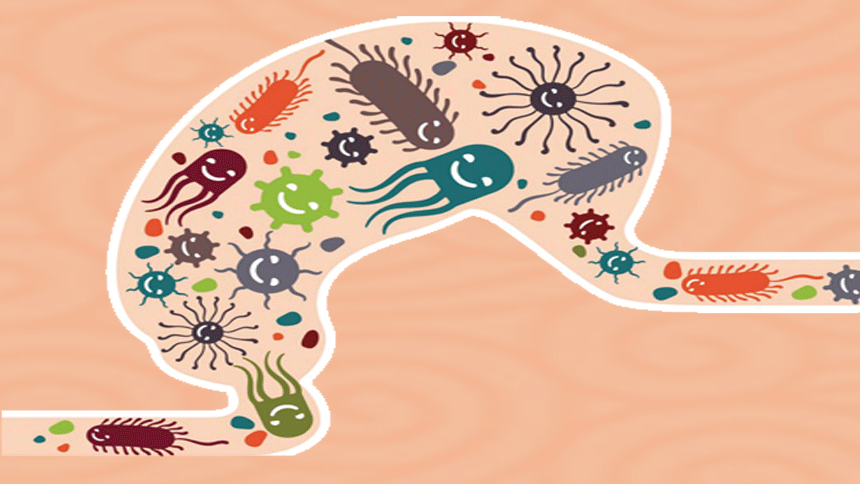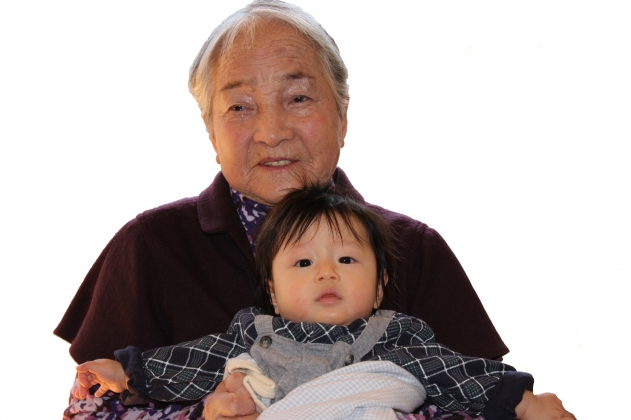Contact Dr. Lu for information about cancer treatments。聯繫盧博士,獲取有關癌症治療資訊。
There is only one common secret of longevity among 457 centenarians in China and Japan | 研究发现:中日457名百岁老人长寿的共同奥秘只有1个
Contact Dr. Lu for information about cancer treatments。聯繫盧博士,獲取有關癌症治療資訊。
[Voice of Hope June 1, 2023] (Editor: Li Wenhan) Have you ever wondered why some people can live to be over a hundred years old, and they are healthy and energetic? Do they have any special secret? The secret to centenarians’ longevity may lie in their guts, new research has found.
Recently, “Nature Aging” published a new study: after analyzing the intestinal flora of 297 centenarians in Guangxi, China, researchers found that centenarians have their own unique intestinal type, similar to young people’s intestinal flora structure and Higher bacterial diversity. This may be the key to longevity.

Gut flora (Voice of Hope Synthesis)
What role do gut microbiota play in health?
Gut flora refers to the trillions of microbes that inhabit our gut, including bacteria, fungi, viruses, and more. These microorganisms not only help us digest food, but also participate in the regulation of our immune system, metabolic system, nervous system and other aspects.
The balance and diversity of gut flora is crucial to our health, and the imbalance or monotony of gut flora may lead to various diseases, such as obesity, diabetes, cardiovascular disease, autoimmune disease, neurodegeneration disease etc.
What are the characteristics of the intestinal flora of centenarians?
A research paper on Japanese centenarians was published in the journal “Nature“, revealing the mystery of their longevity hidden in inconspicuous places.
Japanese scientists studied 160 centenarians (average age 107 years old), and found that long-lived elderly people have unique intestinal flora, and special metabolites can inhibit the growth of intestinal pathogens, reduce inflammation, and promote health.
Specifically, there is a highly enriched type of bacteria in the intestinal flora of centenarians, which can produce a unique set of secondary bile acids through a new biosynthetic pathway.
These secondary bile acids have several important roles, such as regulating the body’s metabolism and immune response, and inhibiting the proliferation of harmful bacteria in the gut.
One of these bile acids, called isoalloLCA, is a potent antimicrobial that, at very low concentrations, can inhibit certain enteric pathogens that have become drug-resistant.
Visible under an electron microscope, isoalloLCA caused Clostridium difficile and Enterococcus faecalis (VRE) to deform and ultimately kill these pathogens.
The researchers also screened dozens of strains of bacteria from the fecal microbes of a centenarian, identified bacterial species that specifically produce isoalloLCA, and mapped the genes and biological enzymes they required in bile acid metabolism.
In follow-up studies, they will further verify the association between bile acids and longevity.

centenarians (pixabay)
What are the characteristics of a centenarian’s diet?
1. Eat more carbohydrates. In the above studies, according to the paper report, the largest source of calories for centenarians in Guangxi is carbohydrates, accounting for more than 60%. This shows that carbohydrates are necessary for longevity.
2. Eat less animal protein and less cholesterol. Centenarians consume only 12% of the high-quality protein that is always talked about. Most of the protein comes from legumes, and if cereals are the main food throughout the day, then protein is 10% of total calorie sources.
3. Take in more dietary fiber. Most of their food composition is coarse grains, and they eat whole grains, potatoes, beans, etc. every day, which form their main carbohydrates and their main source of calories.
Although their calorie intake is low, their dietary fiber content is high. This is a high-fiber dietary pattern, which makes the diversity of their intestinal bacteria closer to the intestinal ecology of young people.
It can be seen that this is a high-carbohydrate, low-protein, high-fiber, high-nutrient diet pattern, which is very similar to the Japanese Okinawa diet pattern.
How to improve our gut flora?
Here are some simple but effective suggestions:
Eat foods rich in prebiotics, such as whole grains, beans, onions, garlic, bananas, etc. These foods can provide nutrients for the beneficial bacteria in the gut.
Appropriate supplementation of probiotics or fermented foods, such as yogurt, sauerkraut, soy milk, etc., can increase the number and types of beneficial bacteria in the intestines.
Eat less high-fat, high-sugar, high-salt, and highly processed foods, which can lead to an imbalance of intestinal flora and inflammation.
Maintain a moderate amount of exercise, exercise can promote intestinal peristalsis, increase blood circulation, and improve the intestinal microenvironment.
Maintain good sleep and mood, sleep and mood can affect our hormone levels and neurotransmitters, which in turn affect our gut flora.

Whole Grain Food, Cereal (Pixabay)
In conclusion, the gut microbiota is an important and neglected system in our body that is closely related to our health and longevity. Centenarians possess unique and optimized gut microbiota, which may be an important factor in their longevity.
We can learn from their lifestyle and eating habits to improve our own gut flora, thereby improving health and longevity.
Editor in charge: Li Zhi
This article or program is edited and produced by Voice of Hope. Please indicate Voice of Hope and include the original title and link when reprinting.
More about this source textSource text required for additional translation information
近日,《自然·衰老》发表一篇最新研究:对中国广西297位百岁老人肠道菌群分析后发现,百岁老人有着自己独特的肠型,与年轻人相似的肠道菌群结构和更高的菌群多样性。这或许就是长寿的关键。

肠道菌群在健康中起到什么作用?
肠道菌群是指居住在我们肠道内的数以万亿计的微生物,包括细菌、真菌、病毒等。这些微生物不仅帮助我们消化食物,还参与我们的免疫系统、代谢系统、神经系统等多个方面的调节。
肠道菌群的平衡与多样性对我们的健康至关重要,而肠道菌群的失衡或单一化则可能导致各种疾病,如肥胖、糖尿病、心血管病、自身免疫性疾病、神经退行性疾病等。
百岁老人的肠道菌群有什么特点?
《自然》杂志上曾发表了一篇有关日本百岁老人的研究论文,为我们揭示了他们隐藏在不起眼处的长寿奥秘。
日本科学家研究了160名百岁人瑞(平均年龄107岁),发现长寿老人们拥有独特的肠道菌群,特殊的代谢产物可以抑制肠道病原体生长,减轻炎症,促进健康。
具体来说,百岁老人的肠道菌群中有一类细菌高度富集,这类细菌能够通过新的生物合成途径,产生一组特有的次级胆汁酸。
这些次级胆汁酸有多种重要作用,例如调节人体代谢和免疫反应,以及抑制有害细菌在肠道中增殖。
其中一种被称为isoalloLCA的胆汁酸有强效的抗菌作用,只需很低的浓度,就可以抑制某些已经有耐药性的肠道病原体。
电子显微镜下可以看到,isoalloLCA引起了艰难梭菌和粪肠球菌(VRE)变形,最终杀死了这些病原体。
研究人员还从一位百岁老人的粪便微生物中筛选了几十株细菌,鉴别出了专门产生isoalloLCA的细菌种类,并绘制出它们在胆汁酸代谢过程中所需的基因和生物酶。
后续研究中,他们还将进一步验证胆汁酸和长寿间的关联。

百岁老人饮食特点是什么?
1、摄入较多的碳水化合物。上述研究中,从论文报告来看,广西的百岁老人最大的热量来源是碳水化合物,占到60%以上。这说明碳水化合物是长寿的必要条件。
2、摄入较少的动物蛋白,较少的胆固醇。总谈论的优质蛋白,百岁老人摄取只有12%。大部分的蛋白质来源于豆类,如果全天以谷物为主食的话,那么蛋白质的来源就是10%。
3、摄入较多的膳食纤维。他们的食物组成里大部分是粗粮,每天吃全谷物、薯类、杂豆等,这些形成他们主要的碳水化合物,也是主要的热量来源。
虽然他们的热量摄入少,但是膳食纤维含量高,这是一种高纤维的饮食模式,才令他们肠道菌的多样性,更接近年轻人的肠道的生态。
可以看出,这是一种高碳水化合物,低蛋白,高纤维,高营养素的饮食模式,与日本冲绳饮食模式很相近。
如何改善我们的肠道菌群?
以下是一些简单而有效的建议:
多吃富含益生元的食物,如全谷物、豆类、洋葱、大蒜、香蕉等,这些食物可以为肠道中有益的细菌提供营养。
适当补充益生菌或发酵食品,如酸奶、酸菜、豆浆等,这些食品可以增加肠道中有益细菌的数量和种类。
少吃高脂、高糖、高盐、高加工的食物,这些食物可以导致肠道菌群失衡和炎症反应。
保持适量的运动,运动可以促进肠道蠕动,增加血液循环,改善肠道微环境。
保持良好的睡眠和心情,睡眠和心情可以影响我们的激素水平和神经递质,进而影响我们的肠道菌群。

总之,肠道菌群是我们身体中一个重要而被忽视的系统,它与我们的健康和寿命密切相关。百岁老人拥有独特而优化的肠道菌群,这可能是他们长寿的一个重要因素。
我们可以借鉴他们的生活方式和饮食习惯,来改善自己的肠道菌群,从而提高健康水平和寿命。
Originally published on https://www.soundofhope.org/post/720686
